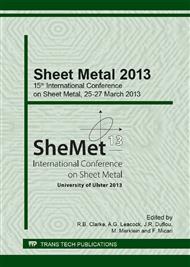p.356
p.364
p.372
p.381
p.389
p.397
p.407
p.415
p.423
Optimized Yield Curve Determination Using Bulge Test Combined with Optical Measurement and Material Thickness Compensation
Abstract:
Axisymmetric die and binder are typically used in the bulge test, where the test specimen is formed by increasing the level of oil pressure (Fig. 1). With this experimental setup a biaxial stress state is induced at the specimen dome, assuming that it is not influenced by friction. The increasing oil pressure in the region of the top of the dome is recorded and the deformation field measured during the forming process. The optical measurement system determines the coordinates, the deformations and the curvature on the outer surface. Based on the forthcoming ISO 16808 these results are directly used for the calculation of the flow curve. In order to determine the flow curve based on the bulge test, an analytical approach is needed for the computation of the stress state at the top of the dome.
Info:
Periodical:
Pages:
389-396
Citation:
Online since:
April 2013
Authors:
Price:
Сopyright:
© 2013 Trans Tech Publications Ltd. All Rights Reserved
Share:
Citation:


